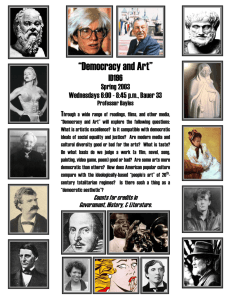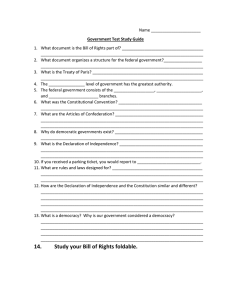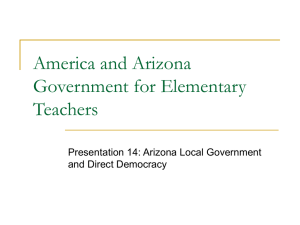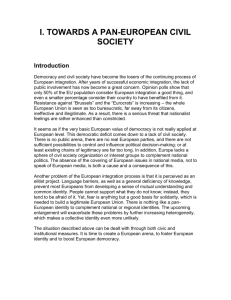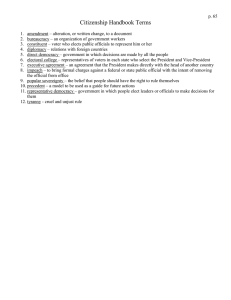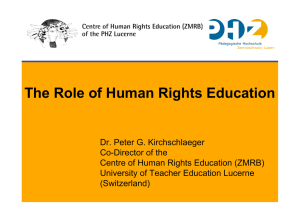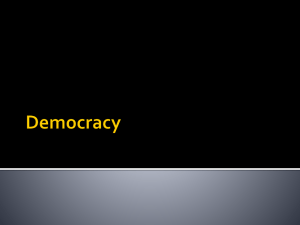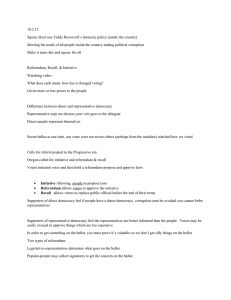These notes are based largely on the BS Frey and...
advertisement
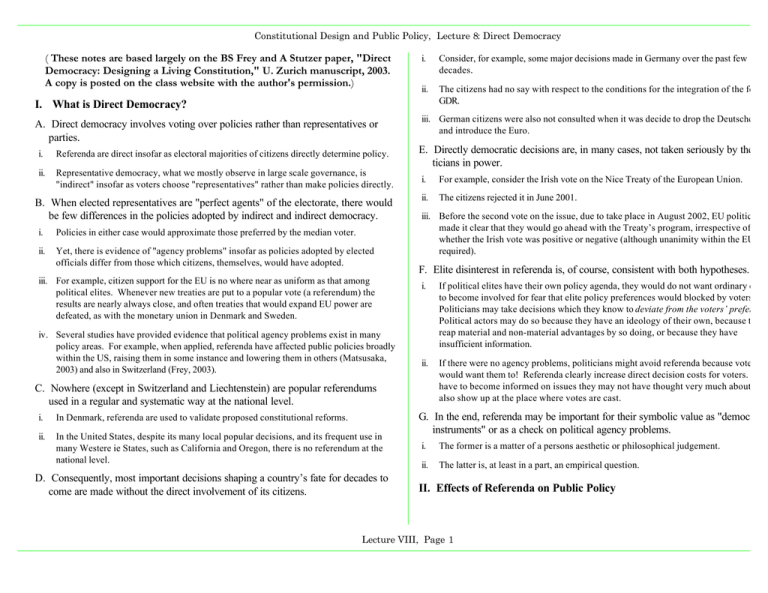
Constitutional Design and Public Policy, Lecture 8: Direct Democracy ( These notes are based largely on the BS Frey and A Stutzer paper, "Direct Democracy: Designing a Living Constitution," U. Zurich manuscript, 2003. A copy is posted on the class website with the author's permission.) i. Consider, for example, some major decisions made in Germany over the past few decades. ii. The citizens had no say with respect to the conditions for the integration of the forme GDR. I. What is Direct Democracy? A. Direct democracy involves voting over policies rather than representatives or parties. i. Referenda are direct insofar as electoral majorities of citizens directly determine policy. ii. Representative democracy, what we mostly observe in large scale governance, is "indirect" insofar as voters choose "representatives" rather than make policies directly. B. When elected representatives are "perfect agents" of the electorate, there would be few differences in the policies adopted by indirect and indirect democracy. i. Policies in either case would approximate those preferred by the median voter. ii. Yet, there is evidence of "agency problems" insofar as policies adopted by elected officials differ from those which citizens, themselves, would have adopted. iii. For example, citizen support for the EU is no where near as uniform as that among political elites. Whenever new treaties are put to a popular vote (a referendum) the results are nearly always close, and often treaties that would expand EU power are defeated, as with the monetary union in Denmark and Sweden. iv. Several studies have provided evidence that political agency problems exist in many policy areas. For example, when applied, referenda have affected public policies broadly within the US, raising them in some instance and lowering them in others (Matsusaka, 2003) and also in Switzerland (Frey, 2003). iii. German citizens were also not consulted when it was decide to drop the Deutsche Ma and introduce the Euro. E. Directly democratic decisions are, in many cases, not taken seriously by the pol ticians in power. i. For example, consider the Irish vote on the Nice Treaty of the European Union. ii. The citizens rejected it in June 2001. iii. Before the second vote on the issue, due to take place in August 2002, EU politicians made it clear that they would go ahead with the Treaty’s program, irrespective of whether the Irish vote was positive or negative (although unanimity within the EU is required). F. Elite disinterest in referenda is, of course, consistent with both hypotheses. i. If political elites have their own policy agenda, they would do not want ordinary citize to become involved for fear that elite policy preferences would blocked by voters. Politicians may take decisions which they know to deviate from the voters’ preference Political actors may do so because they have an ideology of their own, because they reap material and non-material advantages by so doing, or because they have insufficient information. ii. If there were no agency problems, politicians might avoid referenda because voters would want them to! Referenda clearly increase direct decision costs for voters. The have to become informed on issues they may not have thought very much about and also show up at the place where votes are cast. C. Nowhere (except in Switzerland and Liechtenstein) are popular referendums used in a regular and systematic way at the national level. i. In Denmark, referenda are used to validate proposed constitutional reforms. ii. In the United States, despite its many local popular decisions, and its frequent use in many Westere ie States, such as California and Oregon, there is no referendum at the national level. D. Consequently, most important decisions shaping a country’s fate for decades to come are made without the direct involvement of its citizens. G. In the end, referenda may be important for their symbolic value as "democratic instruments" or as a check on political agency problems. i. The former is a matter of a persons aesthetic or philosophical judgement. ii. The latter is, at least in a part, an empirical question. II. Effects of Referenda on Public Policy Lecture VIII, Page 1 Constitutional Design and Public Policy, Lecture 8: Direct Democracy A. In a study covering the 26 Swiss cantons and the years between 1986 and 1997, Feld and Kirchgässner (2001) measure the effects of a mandatory fiscal referendum on aggregate expenditure and revenue. i. In 217 cases of the totally 312 annual observations, cantons adopt a mandatory referendum on new expenditure above a given threshold. ii. They find that expenditure and revenue in cantons with fiscal referendums are lower by about 7 percent and 11 percent respectively, compared to cantons that don’t have this institutional provision. iii. In a sample of 132 large Swiss towns in 1990, the same authors replicate their test for the mandatory referendum on budget deficits. iv. In cities where a budget deficit has to be approved by the citizenry, expenditure and revenue, on average, are lower by about 20 percent, while public debt is reduced by about 30 percent. B. Feld and Matsusaka examine an extended panel data set from 1980 to 1998. The effect of the mandatory expenditure referendum is analyzed, taking the spending threshold into account. i. ii. At the median threshold of 2.5 million Swiss francs (SFR), spending per capita is reduced by 1,314 SFR, i.e. by 18 percent for an average expenditure level of 7,232 SFR (compared to cantons that either have an optional financial referendum or no referendum on new public expenditure). C. Very similar results are found for analyses across US States (Matsusaka 1995 2003). i. In a panel from 1970 to 1999, including all states except Alaska, the effect of the initiat right is estimated on public expenditure, as well as on revenue. ii. The institutional variable (a dummy variable) captures any type of initiative, whether i statutory or for a constitutional amendment. iii. After controlling for the average income in the state, federal aid, population size and growth, the percentage of metropolitan population and whether it is a southern or western state, initiative states, on average, have lower expenditure, as well as lower revenue, than non-initiative states. iv. States with the initiative spend $ 137 less per capita than states that do not provide th initiative, ceteris paribus. v. vi. Both effects are about 4 percent, compared to average expenditure and revenue respectively. vii. The effects are, however, significantly different when the signature requirements to launch an initiative are taken into consideration. a. States with a 2 percent requirement are estimated to levy $ 342 less taxes and fees pe capita than non-initiative states (for the modal signature requirement of 5 percent, revenue is 6 percent lower and expenditure is 5 percent lower) (Matsusaka 2003, chapter 3). The difference in overall spending significantly varies between cantons, applying a low threshold of 0.5 million SFR (25th percentile) and a high threshold of 15 million SFR (75th percentile). b. These effects reflect robust results that can be assigned to the referendum process a not, for example, to the ideology of a state’s electorate. iii. For the former, expenditure is estimated to be lower by 1,389 SFR, while for the latter the reduction is 845 SFR. iv. Moreover, it is found that the mandatory financial referendum has less effect when it is easier for citizens to launch an initiative for a new law or to change an existing law (measured by the signature requirement). v. Thus, there is a substitutive relationship between the two institutions with regard to their consequences on cantonal fiscal outcomes. They also raise less revenue, $ 117 per capita compared to non-initiative states. c. Controlling for roll call voting of state senators, as a proxy for voters’ conservatism, does not change the results in a substantive manner; if anything, the effects for the institutional variable increase (Matsusaka 2003, chapter 3). D. Often these kinds of results are interpreted as clear evidence that direct democ racy produces favorable outcomes for the citizens. i. However, they mainly provide clear evidence against a simple median voter world, in which representatives implement the preferred expenditure and revenue levels of the median voter, and referendums and initiatives would have no effect. In their proposal for a “New Democratic Federalism for Europe”, Frey and Eichenberger (1999) develop a model of federalism that is based on functional overlapping competing jurisdictions (FOCJ) that rely to a large extent on direct democracy. While these findings imply larger deficits and higher public debt in cantons with a fiscal referendum, ceteris paribus, the respective empirical results neither show statistically significant effects on the former measure nor on the latter one (Feld and Kirchgässner 2001, p. 354). In the regression equation, the following are controlled for: income level in the canton, federal aid, age structure of the population, population size, population density, unemployment rate, as well as whether people are German-speaking or not. Lecture VIII, Page 2 Constitutional Design and Public Policy, Lecture 8: Direct Democracy ii. I. However, there is evidence that referenda reduce "legislative shirking." Such e dence is provided by a study on corruption in US states in 1998 (Alt and Lassen 2003). It could well be that low expenditure and revenue levels mainly serve some well-organized interests (e.g. rich people) that rely less on public services. iii. Therefore, the efficiency in the provision of public goods has to be analyzed. E. The cost efficient use of public money under different institutional settings can be directly studied for single publicly provided goods. In a careful study on waste collection, F. Pommerehne (1983, 1990) finds that this service is provided at the lowest cost in Swiss towns that have extended direct democratic participation rights and choose a private contractor. i. If the services are provided by the town instead of a private company, costs are about 10 percent higher. ii. Efficiency losses are about 20 percent in purely representative democratic towns (compared to direct democratic ones). iii. The average cost of waste collection is the highest in towns that rely on representative democratic decision-making only, as well as on publicly organized collection (about 30 percent higher than in the most efficient case). G. Further evidency of the effect of direct democracy on the efficiency of public services comes from a study that relates fiscal referendums to economic performance in Swiss cantons (Feld and Savioz 1997). i. ii. For the years 1984 until 1993, a neoclassical production function is estimated that includes the number of employees in all sectors, cantonal government expenditure for education including grants, as well as a proxy for capital based on investments for building and construction. i. The misuse of public office for private gains is measured based on a survey of state house reporters’ perception of public corruption. ii. It is found that, in addition to a number of control variables, there is a statistically significant effect of voter initiatives on perceived corruption. In initiative states, corruption is lower than in non-initiative states, and this effect is the larger, the lower the signature requirement to launch an initiative. iii. The result is further qualified, as there is only a negative effect on corruption for dire initiatives (but not for indirect initiatives, that have to be approved by the legislator). III. Effects of Referenda on the Process of Political Decision-Making A. There is also evidence that direct democracy fundamentally changes the proce of political decision-making. i. It is not only that politicians are more restricted to follow citizens’ preferences, but the direct involvement of the people changes their motivation when they act as voters, taxpayers or fellow citizens (Frey 1997). ii. This can explain systematic differences as to how well aware of political issues people are, whether they can build up a relationship based on trust to public authorities, and whether they have a preference for, and gain procedural utility from, direct democratic participation rights as such. B. It is widely believed that well-informed citizens are an essential prerequisite for well functioning and stable democracy. The production function is then extended by a dummy variable that identifies cantons with extended direct democratic participation rights in financial issues at the local level. i. iii. Total productivity – as measured by the cantonal GDP per capita – is estimated to be 5 percent higher in cantons with extended direct democracy, compared to cantons where these instruments are not available. If citizens do not have sufficient information about the policies or candidates they vo for, they may be disappointed by the actual consequences of their decisions, which in turn can undermine the acceptance and legitimacy of democracy as a political system. ii. However, collecting information in order to make an informed decision at the poll is a public good that citizens are only willing to make to a limited extent. H. Many of these results could also be explained by imperfect information that lead benign representatives to implementing inferior policies, which happens less frequently in cantons, municipalities and states with direct democratic rights. iii. On the one hand, it can be debated whether a direct democratic decision on a particul issue demands more or less information than the choice of a candidate, given the institutions that lower citizens’ information costs. The index is based on the four main legal instruments for directly influencing the political process in Swiss cantons: (i) the initiative to change a canton’s constitution, (ii) the initiative to change a canton’s laws, (iii) the compulsory or optional referendum to prevent new law or the changing of law and (iv) the compulsory or optional referendum to prevent new state expenditure. Obstacles are measured in terms of (i) the number of signatures necessary to launch an instrument (absolute and relative to the number of citizens with the right to vote), (ii) the legally Lecture VIII, Page 3 Constitutional Design and Public Policy, Lecture 8: Direct Democracy C. On the other hand, it can be asked whether the level of voter information itself is dependent on the political system in which citizens live. i. An illustrative example is the introduction of the Maastricht Treaty in various European countries. ii. In the countries where citizens had the right to vote on it (e.g. Denmark), politicians had to engage much more in explaining the Treaty to the citizens than in countries where no referendum took place (e.g. Germany). iii. For the citizens the incentives to be informed were greater, as the intense discussions before the referendum partly transformed ‘having a reasoned opinion’ into a private good. iv. Casual observation suggests that, as a consequence, information levels on the content of the Treaty were high among Danish citizens. c. On average, citizens living in more direct democratic jurisdictions are objectively bet informed about politics. v. The result holds in a multiple regression framework and indicates that the effect is sizeable. a. For the full range of the institutional variable, an effect is estimated that is comparabl to an increase in education from mere compulsory education to having attended a college providing a diploma at the end. E. The study by Benz and Stutzer (in press) also indicates that political participatio possibilities raise discussion intensity which, in the literature, is seen as an impor tant transmission channel that leads to higher voter information. IV. Direct Democracy and Constitutional Reform A. D. Benz and Stutzer (in press) provide more systematic evidence. i. They study voter information in two different contexts. ii. First, survey data from the Eurobarometer series is used to systematically investigate how referenda in several European countries affected citizens’ information on the European Union (EU). a. The results indicate that people in countries with a referendum are in fact “objectively” better informed (according to 10 questions about the EU in the 1996 Eurobarometer), as well as feeling “subjectively” better informed about the EU after a referendum (Eurobarometer 1992 – 1997). iii. Second, they look at voter information in Switzerland. iv. As a proxy measure for citizens’ awareness of political issues, the number of correct answers to the following three questions is used: (i) “How many parties are in the Federal Council?” (ii) “Who was the president of the Federal Council in 1995?” And (iii) “How many signatures are required for an initiative?” a. Data is obtained from a large survey conducted among the Swiss electorate in 1996. b. Differences across cantons are explained by a measure for the extent of citizens’ participation rights, as well as a number of socio-demographic control variables. In this study, the same broad index is used as in the work on direct democracy and life satisfaction in Switzerland (described in the last subsection). allowed time span in which to collect the signatures and (iii) the level of new expenditure per head allowing a financial referendum. Each of these restrictions is evaluated on a six point scale: ‘one’ indicates a high obstacle, ‘six’ a low one (compulsory referenda are treated like referend with the lowest possible obstacle). Average non-weighted ratings represent the measure used for direct democratic rights in Swiss cantons. Lecture VIII, Page 4
